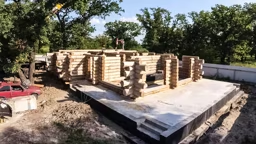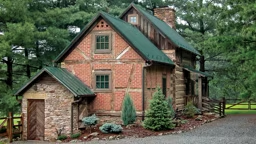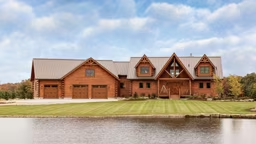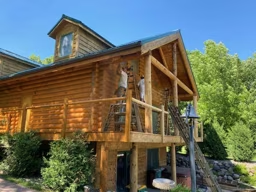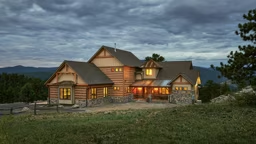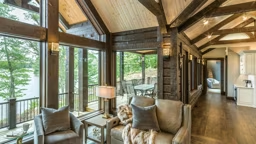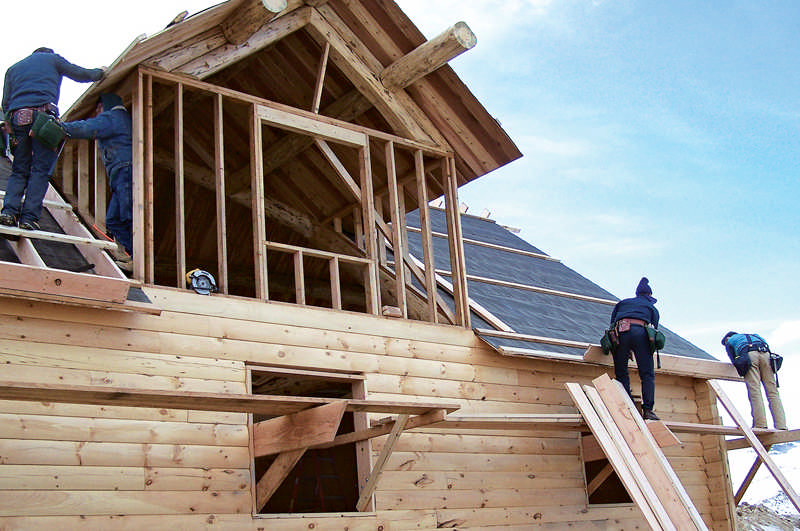
Log homes are built tough. Where other types of housing have succumbed to extreme weather like hurricanes and tornadoes, their log home neighbors have stood strong. Why? It’s all thanks to a carefully engineered building system. A building system is a pre-determined way of assembling the various components to ensure high levels of structural integrity.
Simply put, it’s a plan. How it pertains to log homes is that you can’t just start cutting down trees and setting the trunks on top of each other. The idea is to methodically plan how to stack the logs and hold them in place so that they’ll support each other, the weight of the roof, interior walls and floors — not to mention the furniture and people who live there.
The basis of the building system is engineering, grounded on a thorough knowledge of how wood reacts to various forces, not the least of which is gravity. To meet building codes, log walls must be rigid enough to resist vertical, lateral and shear forces. To create this rigidity, engineers apply complex mathematical formulas to such variables as log size, wood species, profile, corner style, moisture control and the total size of the home.
These engineering calculations can range from a few pages for an individual design to a few hundred pages for an entire line of standard floor plans. The engineered building systems that log home manufacturers develop and that builders follow determine how the individual logs function as a stable unit. The challenge of any of these systems is to accommodate not just the weight of logs, but also their tendency to move and support other components, such as the roof.
Solutions involve the shape of the logs, the way they are stacked and connected and how they’re sealed. There are many ways to design and build log walls and roof systems. To do so properly requires knowledge of many factors. Here are some of the key structural stresses that affect your home’s construction:
Snow Loads
A log home roof system must be built to carry the weight of the heaviest snow load likely to occur in a two-month period in the area where the home is built. For instance, most roofs carry a dead load of 20 pounds per square foot. (Dead load refers to the weight of the inert components, in this case the rafters, decking and shingles and nails.) In localized areas of some snow-belt regions, such as Colorado, the Great Lakes and New England, snow loads of 150 pounds per square foot are common. As a result, the design of the roof system must take snow loads into account in order to produce a safe, sound structure.
Wind Loads
Wind is perhaps the most aggressive force attacking a building’s structural integrity. In a strong wind, a wall acts like a sail. If not properly designed to resist these forces, the house will bend and flex. Over the years, this movement may weaken the connections between walls and the roof. In extreme cases, winds can blow a house down. In most parts of the United States, homes are built to resist wind loads equivalent to a gust of about 80 miles per hour. But along the Gulf and Atlantic coasts — especially in Florida — wind velocity can reach 150 mph during hurricanes. As a result, homes built in these areas need to withstand such forces.
Seismic Loads
When it comes to earthquakes log homes have an advantage over their stiffer counterparts, like brick and masonry housing: Wood is less brittle than these materials and tends to bend and absorb seismic pressures more readily. Even so, building codes in earthquake-prone areas require all homes to take seismic loads into account.
Code Compliance
No matter what part of the United States you build in, when you’re considering buying a log home, you need to know that the package will meet the area’s building codes. Since there can be considerable costs associated with this service, pay particular attention to how your team complies with local code requirements.
A great portion of the code-compliance responsibility falls on your designer, whether it’s an independent architect or a staff designer working for your log home producer. If you choose to enlist the services of a private architect, the log home company you choose simply acts as a supplier of building materials, providing the logs to build the home. If your manufacturer will be working with you on the design, it’s essential they know the construction codes where your site is located.
In addition, your plans may need to be reviewed and stamped by a third-party engineer before you can obtain a building permit. These are all safeguards to ensure your home will be structurally sound. Next, an area building inspector, using the applicable building code as a reference, reviews your home’s design plan and issues a building permit, which is necessary to begin construction and must be clearly posted on the site.
With architectural drawings in hand and the inspector’s seal of approval, it’s now up to your builder to take his or her deep building-code knowledge and apply it to the construction of your log home. In addition to local codes and guidelines, your builder also needs to know the “ICC-400 Standard on the Design and Construction of Log Structures.”
This standard was developed by the National Association of Home Builders’ Log and Timber Homes Council in conjunction with the International Code Council to specifically address the special requirements necessary to full-log home construction. Its purpose is to ensure your log home is properly built and structurally sound, and every log home must be built to this standard.
Make sure the builder you choose is aware of it. During construction, the inspector will periodically return to the job site to ensure that your home is following its approved design. If there are discrepancies, the inspector has the authority to stop construction and order the problem corrected. When all work has been performed satisfactorily, the inspector issues a certificate of occupancy, and you finally get to move into your dream log home.




